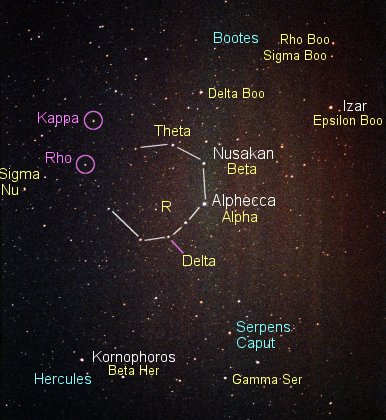 Kappa Corona Borealis used to be a much hotter class A star,
showing that such stars -- which are more massive than the Sun and
frequently have surrounding debris disks -- also have real planets
to go along with them.
Kappa Corona Borealis used to be a much hotter class A star,
showing that such stars -- which are more massive than the Sun and
frequently have surrounding debris disks -- also have real planets
to go along with them.
THE PLANET
The upper circle shows the location of the class K subgiant Kappa
Coronae Borealis (in the constellation Corona
Borealis). The planet orbits Kappa Coronae Borealis in 1191
days (3.26 years), averaging 2.7 Astronomical Units from the star,
which would place it nicely within our asteroid belt 1.8 times
farther than Mars is from the Sun. However, a modest eccentricity
of 0.19 makes the planet sweep from as far as 3.2 AU to Kappa to as
close as 2.2, a range of a full Astronomical Unit, which would make
a fine mess of any asteroid belt that might ever have formed.
Since we do not know the planet's orbital tilt, we can measure only
a lower limit to its mass, which is at least 1.8 times
that of Jupiter.
|
 Kappa Corona Borealis used to be a much hotter class A star,
showing that such stars -- which are more massive than the Sun and
frequently have surrounding debris disks -- also have real planets
to go along with them.
Kappa Corona Borealis used to be a much hotter class A star,
showing that such stars -- which are more massive than the Sun and
frequently have surrounding debris disks -- also have real planets
to go along with them.
 Kappa Corona Borealis used to be a much hotter class A star,
showing that such stars -- which are more massive than the Sun and
frequently have surrounding debris disks -- also have real planets
to go along with them.
Kappa Corona Borealis used to be a much hotter class A star,
showing that such stars -- which are more massive than the Sun and
frequently have surrounding debris disks -- also have real planets
to go along with them.